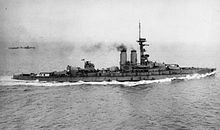HMS Erin
|
|
|
|---|---|
 The Erin 1918 with a captive balloon |
|
| Overview | |
| Type | Battleship |
| Shipyard | |
| Keel laying | December 6, 1911 |
| Launch | September 3, 1913 |
| Commissioning | August 22, 1914 |
| Whereabouts | 1923 sold for demolition |
| Technical specifications | |
| displacement |
22,700 ts |
| length |
o.a. 170.5 m |
| width |
27.7 m |
| Draft |
8.7 m |
| crew |
1070–1130 men |
| drive |
|
| speed |
21 kn |
| Range |
5300 nm at 10 kn |
| Armament |
|
| Fuel supply |
up to 2,120 tons of coal, 710 tons of oil |
|
Armor belt armor |
|
The HMS Erin was a British battleship during the First World War . The name is derived from the Old Gaelic word for Ireland . It had been under construction for the Ottoman Navy at Vickers since 1911 and, as Reshadije , was about to be delivered at the outbreak of World War I , but was confiscated by Great Britain.
She then served in the Grand Fleet and took part in the 1916 Battle of the Skagerrak .
In 1923 she was scrapped because of the limitations of the Washington Naval Agreement .
History of origin
In 1909 the Ottoman Empire initiated negotiations for the construction of two dreadnoughts at British shipyards . The Ottoman Empire wanted to establish a superiority at sea over the Balkan states, with whom it was in a kind of permanent feud. Just a year earlier, she had n't been able to counter the annexation of Crete to Greece .
Initially, designs for comparatively small ships of around 16,000 ts with six main guns were created. Ultimately, however, the focus was on British ships currently under construction, such as the HMS Orion . The ships should be named Reshadije and Rashad I. Hamiss . Reshadije was on December 6, 1911 at the Vickers -Werft in Barrow in Kiel placed and ran on 3 September 1913 by the stack. The construction of the second ship was stopped in 1912 for financial reasons. For this, a semi-finished was at the beginning of 1914 Brazilian battleship bought and renamed Sultan Osman I .
On August 2, 1914, one day after the start of the First World War, the completed Reshadije was to be taken over by the Turkish team. One hour before the handover ceremony, however, British troops occupied the ship and interned the Turkish crew. At the same time, this also happened on the other battleship completed for the Ottoman Empire, the Sultan Osman I , which was put into service by the Royal Navy as HMS Agincourt . These ships would have brought about a shift in the balance of power in the Mediterranean - to the detriment of the Entente , as was feared in the United Kingdom, since the Ottoman Empire was friends with the German Empire .
Use in the First World War
On August 22, 1914, the Royal Navy took over the ship and renamed it HMS Erin . The Erin arrived at Scapa Flow on September 5, 1914 . Initially it was assigned to the 4th Battle Squadron, but then came to the 2nd Battle Squadron , where it took the place of HMS Audacious , which was lost in October 1914 . With this squadron she took part in the Skagerrak Battle on May 31, 1916 , in which she received no hits. For the remainder of the war, she was out of combat.
Fate of the HMS Erin
In 1919 the HMS Erin was transferred to the reserve . According to the provisions of the Washington Naval Agreement of February 6, 1922, the ship was to be scrapped. From 1923 it was scrapped in Queensborough .
literature
- Geoffrey Bennett: The Skagerrakschlacht , Wilhelm Heyne Verlag, Munich (1976), ISBN 3-453-00618-6
- Siegfried Breyer: Battleships and battle cruisers 1905-1970 , JF Lehmanns Verlag, Munich (1970), ISBN 3-88199-474-2
- Randolph Pears: British Battleships 1892–1957: The Great Days of the Fleets . G. Cave Associates (1979), ISBN 978-0906223147
Web links
- HMS Erin battleships-cruisers.co.uk
- HMS Erin dreadnought project
- 1911 British Dreadnought Purchased 1914 Erin Jane's Fighting Ships 1919
- HMS Erin maritimequest
- DREADNOUGHTS August 1914 Strength Residaye and Sultan Osman I naval-history.net
- Erin battleship navypedia
- HMS Erin worldwar1.co.uk
